 Journal of Behavioral and Brain Science, 2013, 3, 7-12 http://dx.doi.org/10.4236/jbbs.2013.31002 Published Online February 2013 (http://www.scirp.org/journal/jbbs) Assessing the Analgesic Effects of Sucrose to Cold Pressor Pain in Human Adults Michele E. Mercer1, Mark D. Holder2 1Department of Psychology, Memorial University of Newfoundland, St. John’s, Canada 2Department of Psychology, University of British Columbia, Kelowna, Canada Email: michelem@mun.ca Received December 28, 2012; revised January 5, 2012; accepted February 18, 2012 ABSTRACT Previous studies report that the ingestion of highly concentrated sweet solutions produces a morphine-like analgesia in rats, human infants, and in adult males. To determine whether sweet-induced analgesia occurs with more commonly consumed substances, 30 adult males (Mage = 22.4 years) were exposed to a cold pressor test and pain responsivity was assessed both before and after consuming either an 8% sucrose solution, water, or nothing. Between-groups compari- sons revealed that re lative to the Sucrose or N othing groups, the Water g roup showed increased pa in tolerance. Neither pain thresholds nor ratings of pain intensity and unpleasantness on a visual analogue scale differed among groups. The results support previous findings in bo th humans and animals that the palatab ility or hedonic valu e of food or drink may be the key predictor of its analgesic effect. Keywords: Sucrose; Analgesia; Pain; Cold Pressor; Humans 1. Introduction The vertebrate endogenous opioid system plays a role in food consumption, particularly in the ingestion of palat- able sweet foods [1]. For example, in humans and other animals, the administration of an opioid agonist (e.g., morphine) increases both the intake of and preference for sucrose [2], whereas an opioid antagonist (e.g., naltrex- one) produces opposite effects [3]. The reciprocal rela- tionship also exists; the consumption of sweet ingesta in- creases endogenous opioid peptide (EOP) activity in rat brain, plasma and cerebral spinal fluid [4-6], and also human plasma [7]. Because EOPs decrease pain, the effect of sweet in- gestion on pain responsivity has been examined [8]. Stu- dies show that intraoral sweet solutions (either dextrose/ saccharin or sucrose) increase rats’ paw-lift latencies from a hot-plate [8-10], an analgesic effect resembling that produced by morphine. Moreover, this sweet-induced analgesia (SIA) is reversed by minimal doses of opioid antagonists (e.g., naltrexone, naloxone) suggesting that EOPs mediate the analgesic effect [8,9,11]. Sweet intake appears to produce analgesia in human infants as well [12-15]. For example, as little as 2 ml of a 12% sucrose solution markedly reduces crying in newborn infants during both circumcision and heel lance procedures [13]. Moreover, the rapid onset of the analgesic effect suggests that it is produced by the sweets’ pleasant taste rather than by its chemical composition or by some post-inges- tive factor [6,12,13]. We know little about whether SIA persists beyond in- fancy. One study investigated the effects of the taste of sucrose on pain responsivity to a cold pressor test (CPT) in 8 to 11-year-old children [16]. Relative to water, su- crose increased children’s pain threshold, but had no af- fect on pain tolerance or pain intensity ratings. A more recent study [17] examined SIA in both 5 to 10-year-old children and their mothers’ responses to cold pressor pain. They found that sucrose increased pain threshold and tolerance of children, but not those of women. The absence of SIA in adults (women) is consistent with re- sults showing that rat SIA progressively declines with age and is absent by the 3rd week of life [9]. However, much more evidence is required before we can determine whether SIA persists into human adulthood. Of particular interest is to determine whether this effect might be more apparent in men. A recent series of studies by Kakeda and colleagues [18-20] reported that after ingestion of a 24% sweet solution, CPT pain thresholds increased in adult males, but not in females. Interestingly however, they found th at there was no effect on pain tolerance bu t conceded that the lack of pain tolerance may have been constrained by a ceiling effect, as more than one third of subjects endured the limited duration (3 min) of cold pressor exposure. The present study attempts to improve upon previous C opyright © 2013 SciRes. JBBS 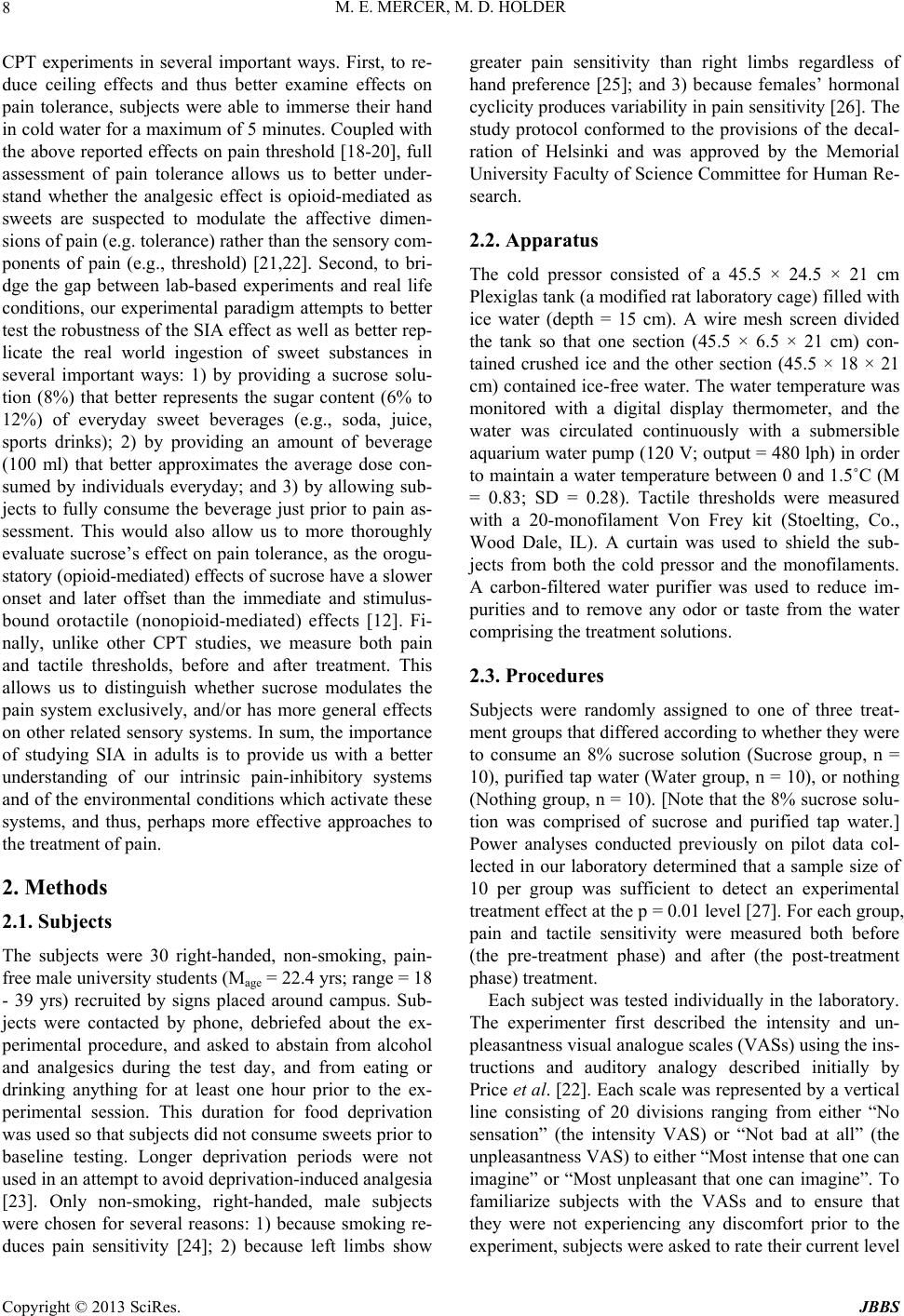 M. E. MERCER, M. D. HOLDER 8 CPT experiments in several important ways. First, to re- duce ceiling effects and thus better examine effects on pain tolerance, subjects were able to immerse their hand in cold water for a maximum of 5 minutes. Coupled with the above reported effects on pain threshold [18-20], full assessment of pain tolerance allows us to better under- stand whether the analgesic effect is opioid-mediated as sweets are suspected to modulate the affective dimen- sions of pain (e.g. tolerance) rather than the sensory com- ponents of pain (e.g., threshold) [21,22]. Second, to bri- dge the gap between lab-based experiments and real life conditions, our experimental paradigm attempts to better test the robustness of the SIA effect as well as better rep- licate the real world ingestion of sweet substances in several important ways: 1) by providing a sucrose solu- tion (8%) that better represents the sugar content (6% to 12%) of everyday sweet beverages (e.g., soda, juice, sports drinks); 2) by providing an amount of beverage (100 ml) that better approximates the average dose con- sumed by individuals everyday; and 3) by allowing sub- jects to fully consume the beverage just prior to pain as- sessment. This would also allow us to more thoroughly evaluate sucrose’s effect on pain tolerance, as the orogu- statory (opioid-mediated) effects of sucrose have a slower onset and later offset than the immediate and stimulus- bound orotactile (nonopioid-mediated) effects [12]. Fi- nally, unlike other CPT studies, we measure both pain and tactile thresholds, before and after treatment. This allows us to distinguish whether sucrose modulates the pain system exclusively, and/or has more general effects on other related sensory systems. In sum, the importance of studying SIA in adults is to provide us with a better understanding of our intrinsic pain-inhibitory systems and of the environmental conditio ns which activate these systems, and thus, perhaps more effective approaches to the treatment of pain. 2. Methods 2.1. Subjects The subjects were 30 right-handed, non-smoking, pain- free male university students (Mage = 22.4 yrs; range = 18 - 39 yrs) recruited by signs placed around campus. Sub- jects were contacted by phone, debriefed about the ex- perimental procedure, and asked to abstain from alcohol and analgesics during the test day, and from eating or drinking anything for at least one hour prior to the ex- perimental session. This duration for food deprivation was used so that subjects did not consume sweets prior to baseline testing. Longer deprivation periods were not used in an attempt to avoid deprivation-induced analgesia [23]. Only non-smoking, right-handed, male subjects were chosen for several reasons: 1) because smoking re- duces pain sensitivity [24]; 2) because left limbs show greater pain sensitivity than right limbs regardless of hand preference [25]; and 3) because females’ hormonal cyclicity produces v ariability in pain sensitivity [26 ]. The study protocol conformed to the provisions of the decal- ration of Helsinki and was approved by the Memorial University Faculty of Science Co mmittee for Human Re- search. 2.2. Apparatus The cold pressor consisted of a 45.5 × 24.5 × 21 cm Plexiglas tank (a modified rat laboratory cage) filled with ice water (depth = 15 cm). A wire mesh screen divided the tank so that one section (45.5 × 6.5 × 21 cm) con- tained crushed ice and the other section (45.5 × 18 × 21 cm) contained ice-free water. The water temperature was monitored with a digital display thermometer, and the water was circulated continuously with a submersible aquarium water pump (120 V; output = 480 lph) in order to maintain a water temperature between 0 and 1.5˚C (M = 0.83; SD = 0.28). Tactile thresholds were measured with a 20-monofilament Von Frey kit (Stoelting, Co., Wood Dale, IL). A curtain was used to shield the sub- jects from both the cold pressor and the monofilaments. A carbon-filtered water purifier was used to reduce im- purities and to remove any odor or taste from the water comprising the treatment solutions. 2.3. Procedures Subjects were randomly assigned to one of three treat- ment groups that differed according to whether they were to consume an 8% sucrose solution (Sucrose group, n = 10), purified tap water (Water group, n = 10), or nothing (Nothing group, n = 10). [Note that the 8% sucrose solu- tion was comprised of sucrose and purified tap water.] Power analyses conducted previously on pilot data col- lected in our laboratory determined that a sample size of 10 per group was sufficient to detect an experimental treatment effect at the p = 0.01 level [27]. For each group, pain and tactile sensitivity were measured both before (the pre-treatment phase) and after (the post-treatment phase) treatment. Each subject was tested individually in the laboratory. The experimenter first described the intensity and un- pleasantness visual analogue scales (VASs) using the ins- tructions and auditory analogy described initially by Price et al. [22]. Each scale was represented by a vertical line consisting of 20 divisions ranging from either “No sensation” (the intensity VAS) or “Not bad at all” (the unpleasantness VAS) to either “Most in tense th at one can imagine” or “Most unpleasant that one can imagine”. To familiarize subjects with the VASs and to ensure that they were not experiencing any discomfort prior to the experiment, subjects were asked to rate their current level Copyright © 2013 SciRes. JBBS 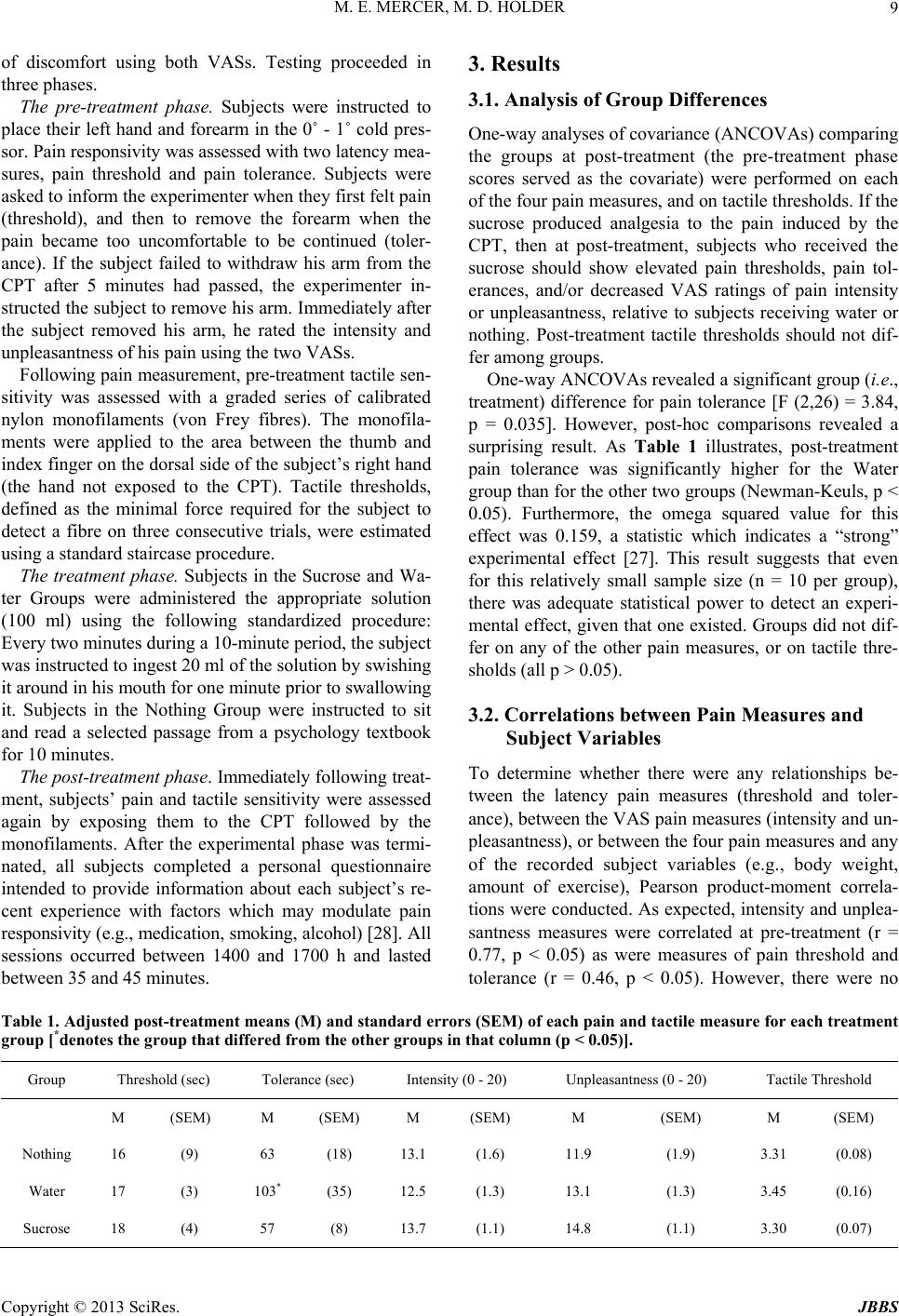 M. E. MERCER, M. D. HOLDER Copyright © 2013 SciRes. JBBS 9 of discomfort using both VASs. Testing proceeded in three phases. The pre-treatment phase. Subjects were instructed to place their left hand and forearm in the 0˚ - 1˚ cold pres- sor. Pain responsivity was assessed with two laten cy me a - sures, pain threshold and pain tolerance. Subjects were asked to inform the experimenter when they first felt pain (threshold), and then to remove the forearm when the pain became too uncomfortable to be continued (toler- ance). If the subject failed to withdraw his arm from the CPT after 5 minutes had passed, the experimenter in- structed the subject to remove his arm. Immediately after the subject removed his arm, he rated the intensity and unpleasantness of his pain using the two VASs. Following pain measurement, pre-treatment tactile sen- sitivity was assessed with a graded series of calibrated nylon monofilaments (von Frey fibres). The monofila- ments were applied to the area between the thumb and index fing er on the dorsal sid e of the subj ect’s right han d (the hand not exposed to the CPT). Tactile thresholds, defined as the minimal force required for the subject to detect a fibre on three consecutive trials, were estimated using a standard staircase procedure. The treatment phase. Subjects in the Sucrose and Wa- ter Groups were administered the appropriate solution (100 ml) using the following standardized procedure: Every two minutes during a 10-minute period, the subject was instructed to ingest 20 ml of the solution by swish ing it around in his mouth for on e minute pr io r to swallow ing it. Subjects in the Nothing Group were instructed to sit and read a selected passage from a psychology textbook for 10 minutes. The post-treatment phase. Immediately following treat- ment, subjects’ pain and tactile sensitivity were assessed again by exposing them to the CPT followed by the monofilaments. After the experimental phase was termi- nated, all subjects completed a personal questionnaire intended to provide information about each subject’s re- cent experience with factors which may modulate pain responsivity (e.g., medication, smoking, alcohol) [28]. All sessions occurred between 1400 and 1700 h and lasted between 35 and 45 m inutes. 3. Results 3.1. Analysis of Group Differences One-way analyses of covariance (ANCOVAs) comparing the groups at post-treatment (the pre-treatment phase scores served as the covariate) were performed on each of the four pain measur es, and on tactile th resho ld s. If the sucrose produced analgesia to the pain induced by the CPT, then at post-treatment, subjects who received the sucrose should show elevated pain thresholds, pain tol- erances, and/or decreased VAS ratings of pain intensity or unpleasantness, relative to subjects receiving water or nothing. Post-treatment tactile thresholds should not dif- fer among groups. One-way ANCOVAs revealed a significant group (i.e., treatment) difference for pain tolerance [F (2,26) = 3.84, p = 0.035]. However, post-hoc comparisons revealed a surprising result. As Table 1 illustrates, post-treatment pain tolerance was significantly higher for the Water group than for the o ther two groups (N ewman-K euls, p < 0.05). Furthermore, the omega squared value for this effect was 0.159, a statistic which indicates a “strong” experimental effect [27]. This result suggests that even for this relatively small sample size (n = 10 per group), there was adequate statistical power to detect an experi- mental effect, g iven that one existed. Groups d id not dif- fer on any of the other pain measures, or on tactile thre- sholds (all p > 0.05). 3.2. Correlations between Pain Measures and Subject Variables To determine whether there were any relationships be- tween the latency pain measures (threshold and toler- ance), between the VAS pain measures (intensity and un- pleasantness), or between the four pain measures and any of the recorded subject variables (e.g., body weight, amount of exercise), Pearson product-moment correla- tions were conducted. As expected, intensity and unplea- santness measures were correlated at pre-treatment (r = 0.77, p < 0.05) as were measures of pain threshold and tolerance (r = 0.46, p < 0.05). However, there were no Table 1. Adjusted post-treatment means (M) and standard errors (SEM) of each pain and tactile measure for each treatment group [*denotes the group that differed from the other groups in that column (p < 0.05)]. Group Threshold (sec) Tolerance (sec) Intensity (0 - 20) Unpleasantness (0 - 20) Tactile Threshold M (SEM) M (SEM) M (SEM) M (SEM) M (SEM) Nothing 16 (9) 63 (18) 13.1 (1.6) 11.9 (1.9) 3.31 (0.08) Water 17 (3) 103* (35) 12.5 (1.3) 13.1 (1.3) 3.45 (0.16) Sucrose 18 (4) 57 (8) 13.7 (1.1) 14.8 (1.1) 3.30 (0.07) 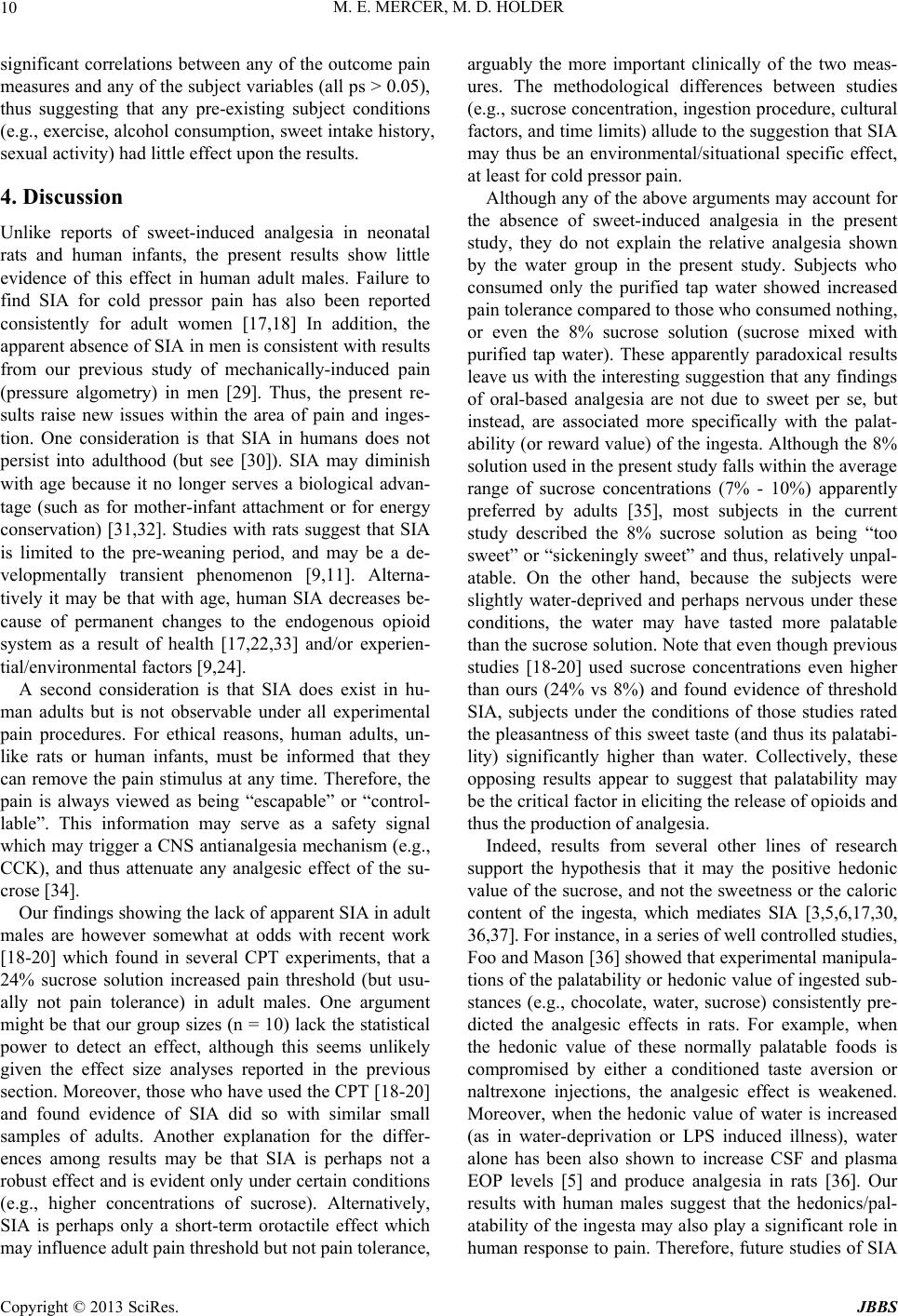 M. E. MERCER, M. D. HOLDER 10 significant correlations between any of the outcome pain measures and any of the subject variables (all ps > 0.05), thus suggesting that any pre-existing subject conditions (e.g., exercise, alcohol consumption, sweet intake history, sexual activity) had little effect upon the results. 4. Discussion Unlike reports of sweet-induced analgesia in neonatal rats and human infants, the present results show little evidence of this effect in human adult males. Failure to find SIA for cold pressor pain has also been reported consistently for adult women [17,18] In addition, the apparent absence of SIA in men is consistent with results from our previous study of mechanically-induced pain (pressure algometry) in men [29]. Thus, the present re- sults raise new issues within the area of pain and inges- tion. One consideration is that SIA in humans does not persist into adulthood (but see [30]). SIA may diminish with age because it no longer serves a biological advan- tage (such as for mother-infant attachment or for energy conservation) [31,32]. Studies with rats suggest that SIA is limited to the pre-weaning period, and may be a de- velopmentally transient phenomenon [9,11]. Alterna- tively it may be that with age, human SIA decreases be- cause of permanent changes to the endogenous opioid system as a result of health [17,22,33] and/or experien- tial/environmental factors [9,24]. A second consideration is that SIA does exist in hu- man adults but is not observable under all experimental pain procedures. For ethical reasons, human adults, un- like rats or human infants, must be informed that they can remove the pain stimulus at any time. Therefore, the pain is always viewed as being “escapable” or “control- lable”. This information may serve as a safety signal which may trigger a CNS antianalgesia mechanism (e.g., CCK), and thus attenuate any analgesic effect of the su- crose [34]. Our findings showing the lack of apparent SIA in adult males are however somewhat at odds with recent work [18-20] which found in several CPT experiments, that a 24% sucrose solution increased pain threshold (but usu- ally not pain tolerance) in adult males. One argument might be that our group sizes (n = 10) lack the statistical power to detect an effect, although this seems unlikely given the effect size analyses reported in the previous section. Moreover, those who have used the CPT [18-20] and found evidence of SIA did so with similar small samples of adults. Another explanation for the differ- ences among results may be that SIA is perhaps not a robust effect and is eviden t only under certain conditions (e.g., higher concentrations of sucrose). Alternatively, SIA is perhaps only a short-term orotactile effect which may influence adult p ain threshold but not pain to lerance, arguably the more important clinically of the two meas- ures. The methodological differences between studies (e.g., sucrose concentration, ingestion procedure, cultural factors, and time limits) allude to the suggestion that SIA may thus be an environmental/situational specific effect, at least for cold pressor pain. Although any of the above arguments may account for the absence of sweet-induced analgesia in the present study, they do not explain the relative analgesia shown by the water group in the present study. Subjects who consumed only the purified tap water showed increased pain tolerance compared to those who consumed nothing, or even the 8% sucrose solution (sucrose mixed with purified tap water). These apparently paradoxical results leave us with the interesting suggestion that any findings of oral-based analgesia are not due to sweet per se, but instead, are associated more specifically with the palat- ability (or reward value) of the ingesta. Although the 8% solution used in th e present study falls with in th e average range of sucrose concentrations (7% - 10%) apparently preferred by adults [35], most subjects in the current study described the 8% sucrose solution as being “too sweet” or “sickeningly sweet” and thus, relatively unpal- atable. On the other hand, because the subjects were slightly water-deprived and perhaps nervous under these conditions, the water may have tasted more palatable than the sucrose so lution. Note th at even though previou s studies [18-20] used sucrose concentrations even higher than ours (24% vs 8%) and found evidence of threshold SIA, subjects under the conditions of those studies rated the pleasantness of this sweet taste (and thus its palatabi- lity) significantly higher than water. Collectively, these opposing results appear to suggest that palatability may be the critical factor in eliciting the release of opioids and thus the produc ti on of anal gesia. Indeed, results from several other lines of research support the hypothesis that it may the positive hedonic value of the sucrose, and not the sweetness or the caloric content of the ingesta, which mediates SIA [3,5,6,17,30, 36,37]. For instance, in a series of well controlled studies, Foo and Mason [36] showed that experimental manipula- tions of the palatability o r hedonic value of ing ested sub- stances (e.g., chocolate, water, sucrose) consistently pre- dicted the analgesic effects in rats. For example, when the hedonic value of these normally palatable foods is compromised by either a conditioned taste aversion or naltrexone injections, the analgesic effect is weakened. Moreover, when the hedonic value of water is increased (as in water-deprivation or LPS induced illness), water alone has been also shown to increase CSF and plasma EOP levels [5] and produce analgesia in rats [36]. Our results with human males suggest that the hedonics/pal- atability of the ing esta may also play a significant role in human response to pain. Therefore, future studies of SIA Copyright © 2013 SciRes. JBBS 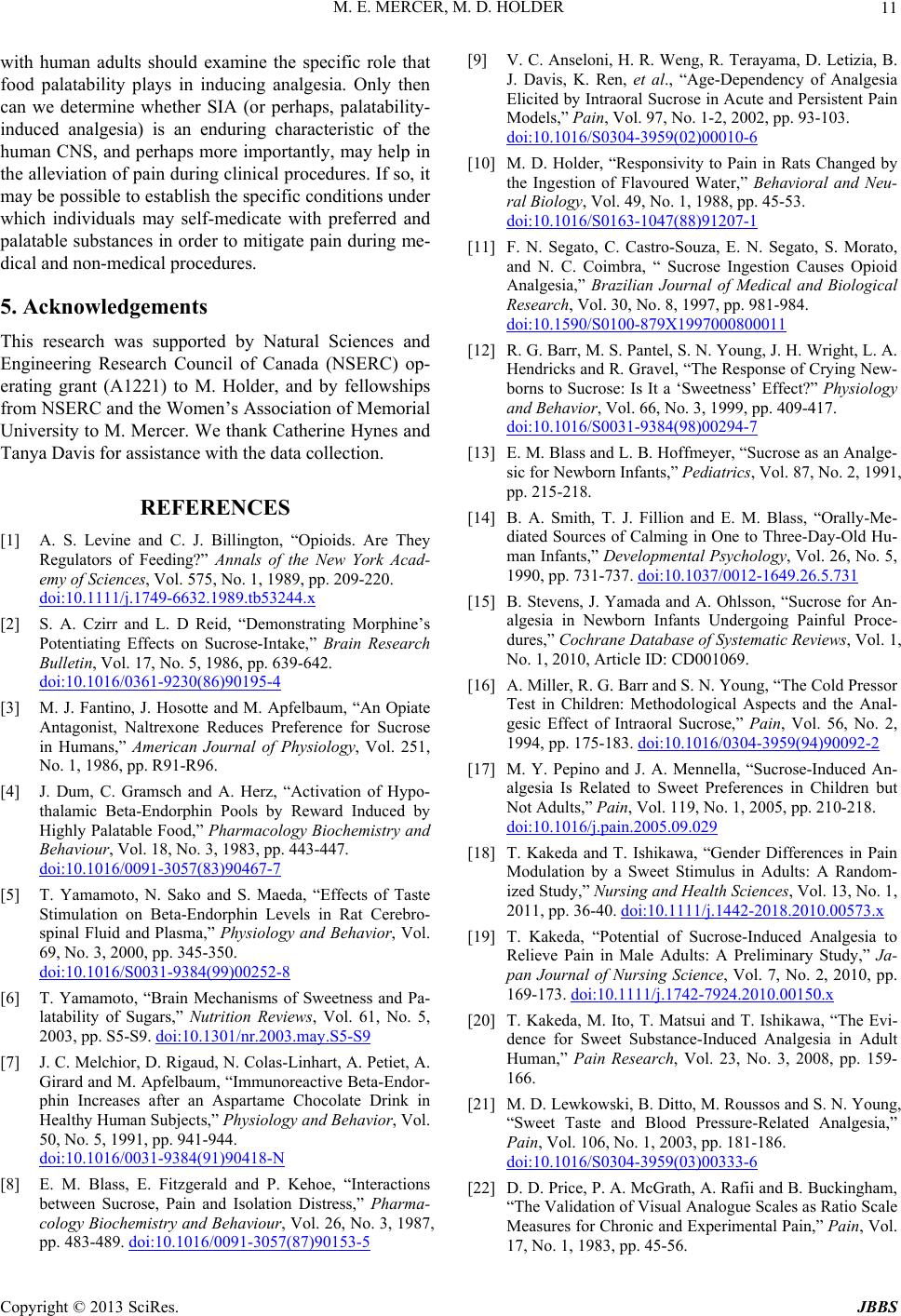 M. E. MERCER, M. D. HOLDER 11 with human adults should examine the specific role that food palatability plays in inducing analgesia. Only then can we determine whether SIA (or perhaps, palatability- induced analgesia) is an enduring characteristic of the human CNS, and perhaps more importantly, may help in the alleviation of pain during clinical procedures. If so, it may be possible to establish the specific conditions under which individuals may self-medicate with preferred and palatable substances in order to mitigate pain during me- dical and non-medical procedures. 5. Acknowledgements This research was supported by Natural Sciences and Engineering Research Council of Canada (NSERC) op- erating grant (A1221) to M. Holder, and by fellowships from NSERC and the Women’s Association of Memorial University to M. Mercer. We thank Catherine Hynes and Tanya Davis for assistance with the data collection. REFERENCES [1] A. S. Levine and C. J. Billington, “Opioids. Are They Regulators of Feeding?” Annals of the New York Acad- emy of Sciences, Vol. 575, No. 1, 1989, pp. 209-220. doi:10.1111/j.1749-6632.1989.tb53244.x [2] S. A. Czirr and L. D Reid, “Demonstrating Morphine’s Potentiating Effects on Sucrose-Intake,” Brain Research Bulletin, Vol. 17, No. 5, 1986, pp. 639-642. doi:10.1016/0361-9230(86)90195-4 [3] M. J. Fantino, J. Hosotte and M. Apfelbaum, “An Opiate Antagonist, Naltrexone Reduces Preference for Sucrose in Humans,” American Journal of Physiology, Vol. 251, No. 1, 1986, pp. R91-R96. [4] J. Dum, C. Gramsch and A. Herz, “Activation of Hypo- thalamic Beta-Endorphin Pools by Reward Induced by Highly Palatable Food,” Pharmacology Biochemistry and Behaviour, Vol. 18, No. 3, 1983, pp. 443-447. doi:10.1016/0091-3057(83)90467-7 [5] T. Yamamoto, N. Sako and S. Maeda, “Effects of Taste Stimulation on Beta-Endorphin Levels in Rat Cerebro- spinal Fluid and Plasma,” Physiology and Behavior, Vol. 69, No. 3, 2000, pp. 345-350. doi:10.1016/S0031-9384(99)00252-8 [6] T. Yamamoto, “Brain Mechanisms of Sweetness and Pa- latability of Sugars,” Nutrition Reviews, Vol. 61, No. 5, 2003, pp. S5-S9. doi:10.1301/nr.2003.may.S5-S9 [7] J. C. Melchior, D. Rigaud, N. Colas-Linhart, A. Petiet, A. Girard and M. Apfelbaum, “Immunoreactive Beta-Endor- phin Increases after an Aspartame Chocolate Drink in Healthy Human Subjects,” Physiology and Behavior, Vol. 50, No. 5, 1991, pp. 941-944. doi:10.1016/0031-9384(91)90418-N [8] E. M. Blass, E. Fitzgerald and P. Kehoe, “Interactions between Sucrose, Pain and Isolation Distress,” Pharma- cology Biochemistry and Behaviour, Vol. 26, No. 3, 1987, pp. 483-489. doi:10.1016/0091-3057(87)90153-5 [9] V. C. Anseloni, H. R. Weng, R. T erayama, D. Letizia, B. J. Davis, K. Ren, et al., “Age-Dependency of Analgesia Elicited by Intraoral Sucrose in Acute and Persistent Pain Models,” Pain, Vol. 97, No. 1-2, 2002, pp. 93-103. doi:10.1016/S0304-3959(02)00010-6 [10] M. D. Holder, “Responsivity to Pain in Rats Changed by the Ingestion of Flavoured Water,” Behavioral and Neu- ral Biology, Vol. 49, No. 1, 1988, pp. 45-53. doi:10.1016/S0163-1047(88)91207-1 [11] F. N. Segato, C. Castro-Souza, E. N. Segato, S. Morato, and N. C. Coimbra, “ Sucrose Ingestion Causes Opioid Analgesia,” Brazilian Journal of Medical and Biological Research, Vol. 30, No. 8, 1997, pp. 981-984. doi:10.1590/S0100-879X1997000800011 [12] R. G. Barr, M. S. Pantel, S. N. Young, J. H. Wright, L. A. Hendricks and R. Gravel, “The Response of Crying New- borns to Sucrose: Is It a ‘Sweetness’ Effect?” Physiology and Behavior, Vol. 66, No. 3, 1999, pp. 409-417. doi:10.1016/S0031-9384(98)00294-7 [13] E. M. Blass and L. B. Hoffmeyer, “Sucrose as an Analge- sic for Newborn Infants,” Pediatrics, Vol. 87, No. 2, 1991, pp. 215-218. [14] B. A. Smith, T. J. Fillion and E. M. Blass, “Orally-Me- diated Sources of Calming in One to Three-Day-Old Hu- man Infants,” Developmental Psychology, Vol. 26, No. 5, 1990, pp. 731-737. doi:10.1037/0012-1649.26.5.731 [15] B. Stevens, J. Yamada and A. Ohlsson, “Sucrose for An- algesia in Newborn Infants Undergoing Painful Proce- dures,” Cochrane Database of Systematic Reviews, Vol. 1, No. 1, 2010, Article ID: CD001069. [16] A. Miller, R. G. Barr and S. N. Young, “The Cold Pressor Test in Children: Methodological Aspects and the Anal- gesic Effect of Intraoral Sucrose,” Pain, Vol. 56, No. 2, 1994, pp. 175-183. doi:10.1016/0304-3959(94)90092-2 [17] M. Y. Pepino and J. A. Mennella, “Sucrose-Induced An- algesia Is Related to Sweet Preferences in Children but Not Adults,” Pain, Vol. 119, No. 1, 2005, pp. 210-218. doi:10.1016/j.pain.2005.09.029 [18] T. Kakeda and T. Ishikawa, “Gender Differences in Pain Modulation by a Sweet Stimulus in Adults: A Random- ized Study,” Nursing and Health Sciences, Vol. 13, No. 1, 2011, pp. 36-40. doi:10.1111/j.1442-2018.2010.00573.x [19] T. Kakeda, “Potential of Sucrose-Induced Analgesia to Relieve Pain in Male Adults: A Preliminary Study,” Ja- pan Journal of Nursing Science, Vol. 7, No. 2, 2010, pp. 169-173. doi:10.1111/j.1742-7924.2010.00150.x [20] T. Kakeda, M. Ito, T. Matsui and T. Ishikawa, “The Evi- dence for Sweet Substance-Induced Analgesia in Adult Human,” Pain Research, Vol. 23, No. 3, 2008, pp. 159- 166. [21] M. D. Lewkowski, B. Ditto, M. Roussos and S. N. Young, “Sweet Taste and Blood Pressure-Related Analgesia,” Pain, Vol. 106, No. 1, 2003, pp. 181-186. doi:10.1016/S0304-3959(03)00333-6 [22] D. D. Price, P. A. McGrath, A. Rafii and B. Buckingham, “The Validation of Visual Analogue Scales as Ratio Scale Measures for Chronic and Experimental Pain,” Pain, Vol. 17, No. 1, 1983, pp. 45-56. Copyright © 2013 SciRes. JBBS 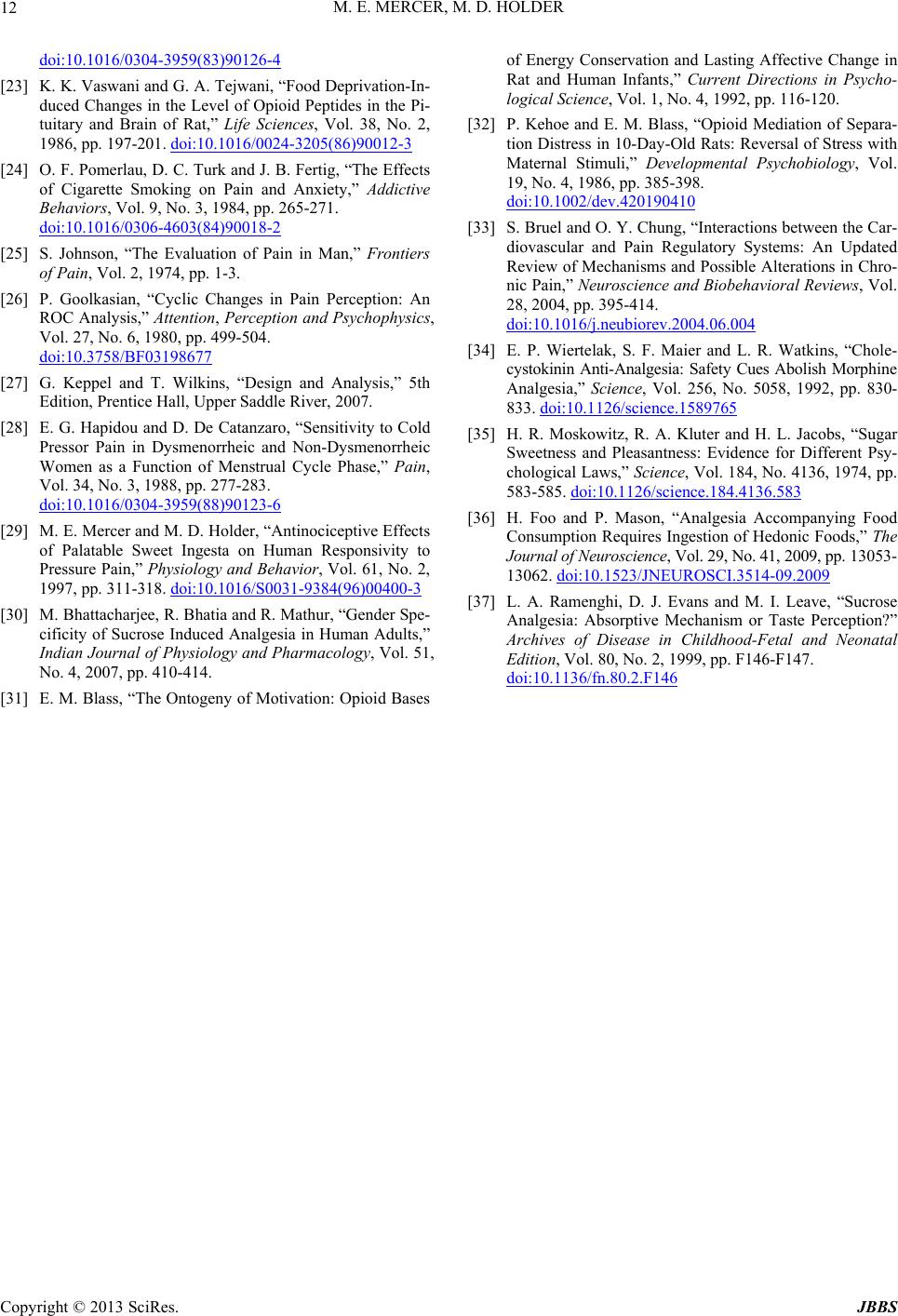 M. E. MERCER, M. D. HOLDER Copyright © 2013 SciRes. JBBS 12 doi:10.1016/0304-3959(83)90126-4 [23] K. K. Vaswani and G. A. Tejwani, “Food Deprivation-In- duced Changes in the Level of Opioid Peptides in the Pi- tuitary and Brain of Rat,” Life Sciences, Vol. 38, No. 2, 1986, pp. 197-201. doi:10.1016/0024-3205(86)90012-3 [24] O. F. Pomerlau, D. C. Turk and J. B. Fertig, “The Effects of Cigarette Smoking on Pain and Anxiety,” Addictive Behaviors, Vol. 9, No. 3, 1984, pp. 265-271. doi:10.1016/0306-4603(84)90018-2 [25] S. Johnson, “The Evaluation of Pain in Man,” Frontiers of Pain, Vol. 2, 1974, pp. 1-3. [26] P. Goolkasian, “Cyclic Changes in Pain Perception: An ROC Analysis,” Attention, Perception and Psychophysics, Vol. 27, No. 6, 1980, pp. 499-504. doi:10.3758/BF03198677 [27] G. Keppel and T. Wilkins, “Design and Analysis,” 5th Edition, Prentice Hall, Upper Saddle River, 2007. [28] E. G. Hapidou and D. De Catanzaro, “Sensitivity to Cold Pressor Pain in Dysmenorrheic and Non-Dysmenorrheic Women as a Function of Menstrual Cycle Phase,” Pain, Vol. 34, No. 3, 1988, pp. 277-283. doi:10.1016/0304-3959(88)90123-6 [29] M. E. Mercer and M. D. Holder, “Antinociceptive Effects of Palatable Sweet Ingesta on Human Responsivity to Pressure Pain,” Physiology and Behavior, Vol. 61, No. 2, 1997, pp. 311-318. doi:10.1016/S0031-9384(96)00400-3 [30] M. Bhattacharjee, R. Bhatia and R. Mathur, “Gender Spe- cificity of Sucrose Induced Analgesia in Human Adults,” Indian Journal of Physiology and Pharmacology, Vol. 51, No. 4, 2007, pp. 410-414. [31] E. M. Blass, “The Ontogeny of Motivation: Opioid Bases of Energy Conservation and Lasting Affective Change in Rat and Human Infants,” Current Directions in Psycho- logical Science, Vol. 1, No. 4, 1992, pp. 116-120. [32] P. Kehoe and E. M. Blass, “Opioid Mediation of Separa- tion Distress in 10-Day-Old Rats: Reversal of Stress with Maternal Stimuli,” Developmental Psychobiology, Vol. 19, No. 4, 1986, pp. 385-398. doi:10.1002/dev.420190410 [33] S. Bruel and O. Y. Chung, “Interactions between the Car- diovascular and Pain Regulatory Systems: An Updated Review of Mechanisms and Possible Alterations in Chro- nic Pain,” Neuroscience and Biobehavioral Reviews, Vol. 28, 2004, pp. 395-414. doi:10.1016/j.neubiorev.2004.06.004 [34] E. P. Wiertelak, S. F. Maier and L. R. Watkins, “Chole- cystokinin Anti-Analgesia: Safety Cues Abolish Morphine Analgesia,” Science, Vol. 256, No. 5058, 1992, pp. 830- 833. doi:10.1126/science.1589765 [35] H. R. Moskowitz, R. A. Kluter and H. L. Jacobs, “Sugar Sweetness and Pleasantness: Evidence for Different Psy- chological Laws,” Science, Vol. 184, No. 4136, 1974, pp. 583-585. doi:10.1126/science.184.4136.583 [36] H. Foo and P. Mason, “Analgesia Accompanying Food Consumption Requires Ingestion of Hedonic Foods,” The Journal of Neuroscience, Vol. 29, No. 41, 200 9, pp. 13053- 13062. doi:10.1523/JNEUROSCI.3514-09.2009 [37] L. A. Ramenghi, D. J. Evans and M. I. Leave, “Sucrose Analgesia: Absorptive Mechanism or Taste Perception?” Archives of Disease in Childhood-Fetal and Neonatal Edition, Vol. 80, No. 2, 1999, pp. F146-F147. doi:10.1136/fn.80.2.F146
|